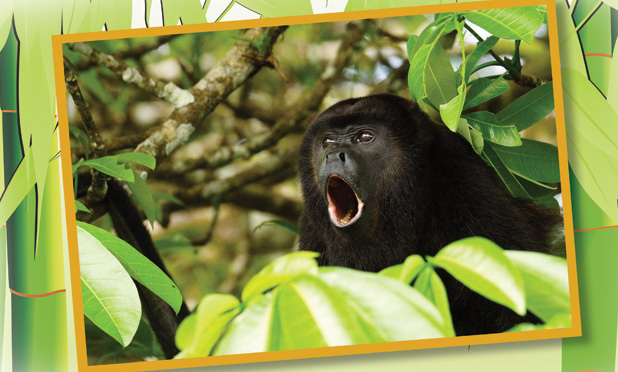The science of the microbiome is arguably one of the hottest topics in medicine, and rightfully so. A deeper understanding of the ecology of the flora in our bodies is providing revolutionary insight beyond the simple form and function of our major parts. This new frontier is dauntingly complex, and most studies focus on details, failing to place these microbial ecosystems within the larger context of evolutionary time and environment.
Dr. Katherine Amato, a biological anthropologist from Northwestern University in Chicago, Illinois, believes this broader context is perhaps the key to understanding the many roles microbes play. In studying the gut microbiota of nonhuman primates, she is decoding important patterns, both divergent and convergent, between ourselves and our cousins that might one day change our understanding of the microbial world within. We talked with Amato recently to find out more about her work.
IEEE Pulse: What is the major question you’re trying to answer about the primate microbiome?

Katherine Amato: First and foremost, how are gut microbes helping primates in the wild? We know that microbes have been associated with us as humans and primates and mammals for years and years across evolutionary time, and we assume that they’re there because they’re doing something for us. Presumably, microbes are having some sort of effect on their host in a way that’s making it easier for hosts to divide and reproduce. I go out and I observe the primates in the wild, and I look at what they’re eating, try to understand how active they are, what percent of their activity they are devoting to different sorts of behaviors. I then collect fecal samples to analyze the microbial communities in order to understand how the microbes might be informing or influencing the primate’s behavior.
IEEE Pulse: How in the world do you collect fecal samples from wild monkeys? And once you’ve collected them, what do you do?
Amato: When I’m actually in the field, I wake up before the sun is up every day, go out into the forest, find a monkey, and then I follow them around all day watching them with binoculars to see everything they’re doing. At some point, they’ll defecate, and that’s kind of “action” time. The monkeys I study are mostly howler monkeys, which spend basically all of their time in trees, so their fecal samples are falling from the trees to the ground. That makes collection a little bit tricky.
Back at the lab, we use all DNA-based methods to study the microbes within the samples. A lot of these microbes that are in the gut are really hard to grow and culture. DNA allows us to get around problems because we don’t need to grow the microbes to figure out who they are and what they’re doing. We use a technology called next-generation sequencing, which allows us to cover the whole microbial community effectively.
IEEE Pulse: Why are howler monkeys useful models for the human microbiome?
Amato: Howler monkeys have the ability during certain periods within a year to eat a lot of leaves. They tend to prefer fruit, but when there isn’t fruit, they tend to switch their diet over to leaves. Like us, their diet can be quite variable, so they can eat different things from month to month. And also like us, they don’t have a very specialized gut morphology. Most other primates that eat large amounts of leaves have a sacculated foregut, a specialized structure analogous to the rumen of a cow, which helps them deal with fiber and toxins in the leaves that are typically hard to digest. Howler monkeys don’t have that, making their digestive morphology pretty similar to that of humans.
So one of the interesting questions is how can gut microbes help this monkey consume this type of diet without specialized gut morphology? I’ve found that when howler monkeys consume less energy in their diet, their gut microbes produce more short-chain fatty acids, which the monkeys absorb and use as energy. So when the howler monkeys were eating leaves, which provide them the least amount of energy, there were changes in their microbial communities that seemed to make digestion more efficient for that diet.
IEEE Pulse: What does this tell us about ourselves?
Amato: We’ve had a lot of diet changes over our evolutionary existence, so it’s possible that the gut microbes that we have also helped us shift our diet to some extent. Humans went from eating a more leafy diet to a diet that’s heavier in meat to hunter-gathering to agriculture. Meat-eating perhaps helped us to evolve larger brains by giving us the nutrients we needed more easily. The brain is the most energetically expensive tissue in the body aside from the gut, and so to have a large brain, you need to have a lot of energy and nutrients to power it. Maybe more efficient gut microbes enabled us to meet this need. In the case of the howler monkeys, their gut microbial communities appear to be helping them fill nutritional gaps from one diet to another, so it could be possible.
IEEE Pulse: If this is true, might it also mean that these superefficient microbes make us more susceptible to obesity?
Amato: We know that gut microbes interact very closely with the immune system. We know they interact very closely with the nervous system, and that they can modulate our metabolism and basically affect how a person’s metabolism is working, for lack of a better term. It may be that certain microbial communities started to interact with human physiology in a different way, changing how energy was being produced or allocated in the body, how fat was being stored, where it was going.
Studies have shown that gut microbes could be contributing to obesity, partially, because some people might have types of microbes that are more efficient at extracting energy from their diet. If they are then absorbing that energy, and not using it, that energy gets stored as fat, which contributes to people being overweight and to metabolic disease. By comparing primates and humans, we might be able to really drive it down into the mechanism of why this is happening.
IEEE Pulse: What do you think the major questions are going to be in the coming decades?
Amato: There’s a lot of work right now looking at how gut microbes influence human health, but most of it takes more of a focused, somewhat clinical perspective. I think if we understand the similarities and differences between primates and humans, that could strongly influence how we view human diseases and the development of therapies. I also think, in addition to the kind of the health care focus, the big question is how do gut microbes fit into these models of ecology and evolution that we already have? Can they explain some of these consistencies that we’re seeing in the way that we explain things right now? Or are they actually contributing to processes that determine how the host’s diet, physiology, activity, and behavior shifts? I tend to think it’s the latter.



